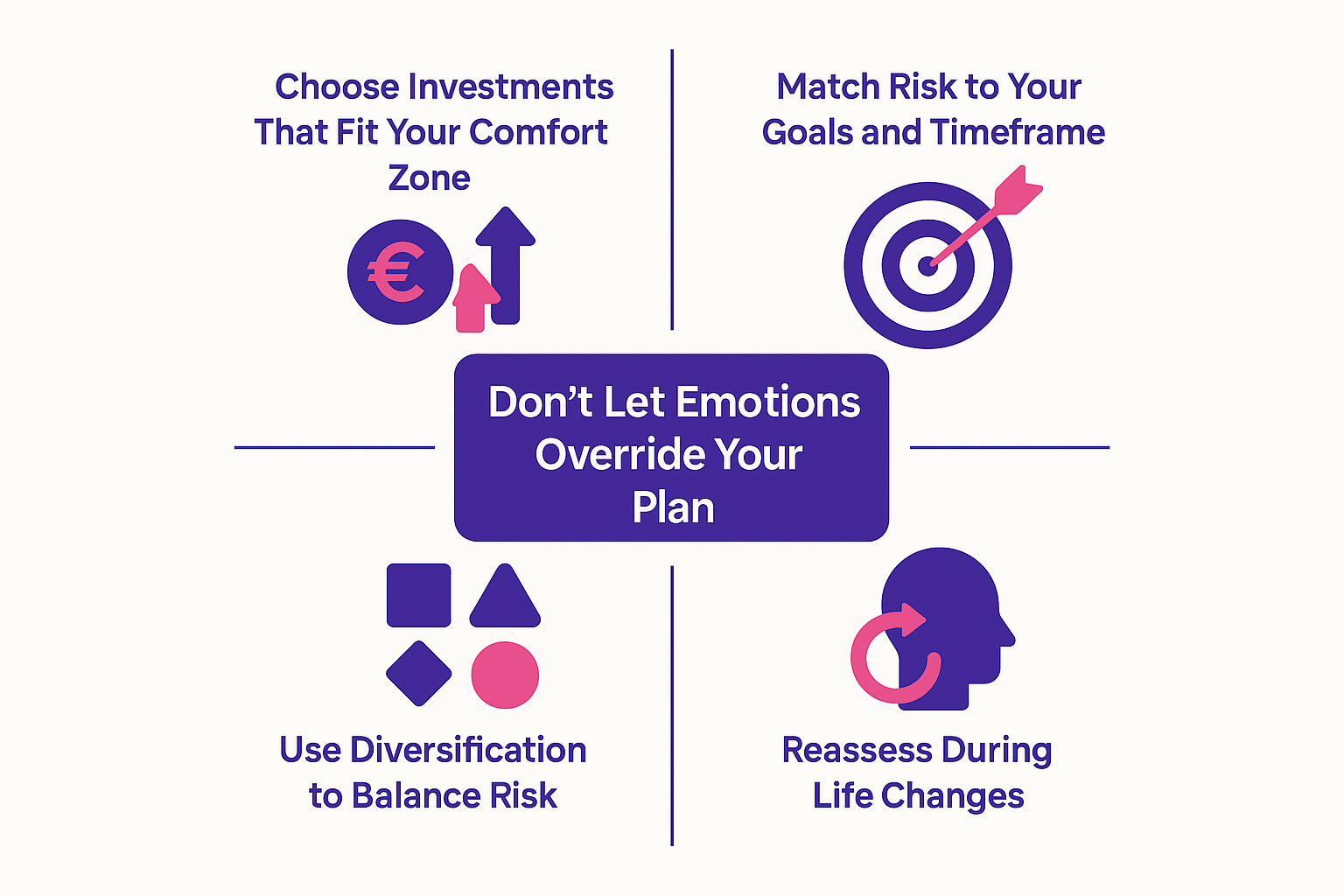Table of Contents
If you’re just starting your investment journey, one concept you’ll hear frequently is risk tolerance. Before you invest a single euro, it’s worth taking a step back and asking yourself how comfortable you are with risk.
In this third article of our Beginner Investor Blog Series, we’ll break down what risk tolerance means, how to figure out yours and share simple tips to help you use it to make smarter, more efficient investment decisions.
Missed the previous Beginner Investor Blog Series? Read it here:
What Is Risk Tolerance?
Risk tolerance refers to the level of uncertainty and potential loss you’re comfortable with when it comes to your investments, especially during market downturns.
Imagine this: you invest €10,000, and a few months later, it drops to €8,500. Do you panic and sell? Feel anxious, but hang in there? Or maybe see it as a chance to buy more while prices are low? How you react says a lot about your risk tolerance.
It’s a mix of your emotional comfort with market ups and downs, your financial situation (such as what you can afford to lose), and your time horizon, which is how long you plan to leave the money invested.
Everyone’s different. What feels like a significant risk to one person might feel manageable to someone else.
What Affects Your Risk Tolerance?
Your risk tolerance is usually shaped by:
Your Age
Younger investors often take more risk because they have time to recover from market drops.
A large European study across six countries, including the UK, France, Germany, and Spain, found that people tend to take less investment risk as they get older, especially after age 45.
Another survey showed that 38% of millennials (born between 1981 and 1996) were putting their money into riskier investments, compared to just 24% of baby boomers (born between 1946 and 1964). This supports the idea that younger investors are generally more willing to take risks than older generations.
However, a study by Trinity College Dublin found that age alone isn’t a clear predictor of financial risk tolerance in Ireland. While factors such as gender and education showed a stronger link to the amount of risk someone is willing to take, age didn’t have the same influence. This suggests that other things, like your financial goals, past investment experience, and confidence with money, play a bigger role in shaping your attitude towards risk.
Your Gender
Whether you’re male or female can influence how likely you are to invest. A recent survey by the Banking & Payments Federation Ireland (BPFI) found that 44% of men in Ireland have investments, compared to just 26% of women (not including pensions or their home). This shows that men are more likely to invest, while many women may be missing out. The gap could be due to confidence, lack of information, or simply not knowing where to start. With the right support and advice, more women could feel comfortable taking that first step into investing.
Your Income and Assets
Your financial situation plays a significant role in how much risk you can take. If you have a steady income, some savings set aside, and little or no debt, you’re in a stronger position to handle the ups and downs of investing. This kind of financial security can make you feel more comfortable taking on risk, because you know your basic needs are covered. On the other hand, if money is tight or you’re relying on your investments for short-term goals, it might make more sense to play it safe.
Your Investment Goals
What you’re investing in can significantly impact how much risk makes sense for you. If your goal is long-term, such as saving for retirement in 20 or 30 years, you can usually afford to take on more risk; your investments have time to recover from any short-term dips.
However, if your goal is short-term, like saving for a house deposit in the next couple of years, it’s better to stick with safer options. That way, your money is there when you need it, without worrying about market ups and downs.
Your Experience and Knowledge
How much you know about investing can also shape how much risk you’re comfortable with. If you’re new to investing, it’s perfectly normal to feel cautious and prefer safer options initially. You might want to ease in slowly, learn how the markets work, and build your confidence over time.
On the other hand, if you’ve been investing for a while and understand how markets rise and fall, you might feel more at ease taking on a bit more risk. The more experience and knowledge you gain, the more comfortable you may become with making informed investment decisions.
Start planning for your future today. Get a savings & investments quote!
Why Knowing Your Risk Tolerance Matters Before You Invest
Understanding your risk tolerance is one of the most important steps before you start investing. If you choose investments that are too risky for your comfort level, you might panic when the market drops and end up selling at the worst possible time, turning a temporary dip into a real loss. On the flip side, if you’re too cautious, you might avoid risk altogether and miss out on the chance to grow your money over the long term.
Knowing your risk tolerance helps you:
- Pick investments that match your goals and personality
- Stay calm and stick to your plan when markets go up and down
- Avoid emotional decisions (and sleepless nights!)
In short, it’s the foundation of a smart, confident investment strategy.
How Risk Is Measured
When you’re choosing where to invest your money, it’s essential to understand the level of risk involved. Most investment providers label their funds with a risk rating to make this easier. These ratings usually fall into three main categories: very low risk, medium risk, and high risk. Each one comes with its own level of potential reward and potential downsides. Here’s a simple breakdown to help you figure out what might suit you best:
Very Low Risk
- What it means: These are the most stable investment options with little to no fluctuation in value.
- Who it suits: People who prioritise capital protection and want to avoid losses; ideal for short-term savings or very cautious investors.
- Risk vs. reward: Minimal risk of losing money, but growth is slow and may not keep up with inflation.
Medium Risk
- What it means: These investments offer a balanced approach, with some ups and downs, but not extreme.
- Who it suits: Investors with a moderate risk tolerance who want long-term growth without too much volatility.
- Risk vs. reward: Offers the potential for steady returns over time, with moderate risk of short-term dips.
High Risk
- What it means: These investments can grow quickly but are also more likely to fluctuate in value.
- Who it suits: Long-term investors who are comfortable with market swings and can afford to wait out downturns.
- Risk vs. reward: Higher potential returns, but also a higher chance of short-term losses.
Understanding these categories can help you select investments that align with your personal risk tolerance and financial objectives.
How to Find Out Your Risk Tolerance
One of the best ways to understand your risk tolerance is to talk to a financial advisor. They can guide you through the process by examining your complete financial picture, including your income, savings, goals, and the duration of your investment plan. It’s not just about finding out whether you’re cautious or adventurous with money; it’s about figuring out what kind of investment strategy works best for your situation.
For example, if you’re getting close to retirement, it might make sense to reduce your investment risk to protect what you’ve already built. A financial advisor can help you strike the right balance between risk and security.
Let’s find the right plan for your goals! Start with a personalised quote now.
How to Make Your Risk Tolerance Work for You
Here are some simple tips on how to use your risk tolerance to make your investments more efficient and better suited to you:
Choose Investments That Fit Your Comfort Zone
Don’t just chase returns; select investments that align with your risk tolerance. If you’re risk-averse, consider low-volatility options such as government bonds or conservative funds. If you’re more comfortable with risk, you can consider shares or property funds. Staying within your comfort zone helps you stick with your plan during market ups and downs.
Match Risk to Your Goals and Timeframe
Different goals are equal to different risks. Saving for a home in 2 years? Stay low risk. Investing for retirement in 25 years? You can take more risks early on and scale back later. Always match the risk level of your investments to the timing and importance of your goals.
Use Diversification to Balance Risk
Regardless of your tolerance, diversifying your investments across different asset types (e.g., cash, shares, property, and bonds) helps mitigate the impact of any single investment performing poorly. It’s one of the easiest ways to manage risk without sacrificing potential growth.
Reassess During Life Changes
Your risk tolerance can change when your life does, such as a new job, marriage, kids, inheritance, or even a market downturn. Revisit your investment mix after significant changes to ensure it still aligns with your current situation.
Don’t Let Emotions Override Your Plan
Knowing your risk tolerance helps you stay calm when the market dips. If you’ve planned for your level of risk, you’re less likely to panic sell, which is when many investors lock in losses. Stick to the plan that fits you, not what the headlines say.
Not sure where to begin? We’ll help you every step of the way!
Get a Savings & Investments Quote
Investing always comes with some level of risk; there’s no avoiding it. However, the good news is that you can manage this risk by understanding your comfort level and selecting investments that align with your personal goals. When you start with your risk tolerance, everything else in your investment plan becomes easier to shape.
Ready to make your money work harder for you? Get a free quote today and take the first step towards building a stronger financial future.
Our next Beginner Investor Blog Series post will dive into Mistakes First-Time Investors Make (and How to Avoid Them). Stay tuned!
We provide a wide variety of financial services, such as mortgages, serious illness cover, pensions, financial planning, health insurance, and savings & investments.
Share this post
All our content has been written or overseen by a qualified financial advisor. However, you should always seek individual financial advice for your unique circumstances.
Warning: Past performance is not a reliable guide to future performance.
Warning: The value of your investment may go down and up.
Warning: If you invest in this product, you will not have any access to your money until you retire.
Warning: If you invest in this product, you may lose some or all of your investment.
Warning: This product may be affected by changes in currency exchange rates.






